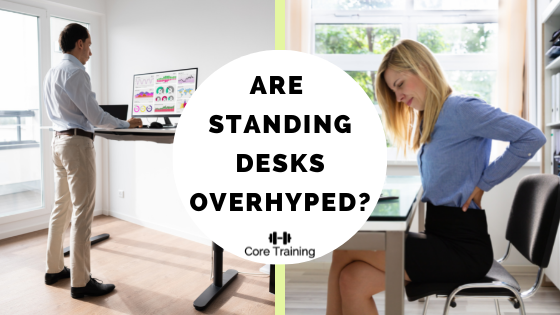Are Standing Desks Overhyped?
In recent years, we’ve all been made aware of the ‘harm’ we can be doing to our bodies, posture and mobility from being stuck sat behind a desk all day, every day. We’ve been told or shown how doing so can lead to ‘rounded’ shoulders, tight hips and lower back pain. All of this culminates in ‘bad’ posture, which must be addressed and ‘fixed’. And the answer is seemingly to swap out your regular desk for a standing desk - being on your feet, it is suggested, will help us keep better posture, and reduce lower back pain and muscle tightness. But is that actually the case, and are standing desks as great as we are told?
The short answer is, quite simply, no. I say this, not because standing desks are bad, but because they have somehow become a miracle ‘cure-all’ for some people. When preparing to write this blog, I googled the ‘benefits of a standing desk’ and was told that they would lower blood glucose, reduce risk of obesity, reduce lower back pain, reduce risk of heart disease (really?!) and boost productivity. Now, there are some very tenuous arguments being made there - particularly when we are essentially talking about a table with extra long legs. Could using a standing desk indirectly contribute to some of these benefits? Of course, but only in certain circumstances, and not in isolation.
Now, the main proposed benefit of standing desks is not any of the more outlandish claims I listed, but rather in relation to posture, and specifically lower back stiffness/pain. While the idea of using a standing desk, not being sat in a hunched over position, being beneficial for correcting lower back pain and poor posture, the evidence doesn’t really support this. First of all, posture and pain are not intrinsically linked. That is to say, if you aren’t experiencing pain, limited mobility or other complications, then there is no need or incentive to actually ‘correct’ your posture. And on the other side of it, if you are experiencing these symptoms of pain or stiffness, ‘correcting’ your posture is unlikely to get rid of these symptoms on its own.
However, none of that is to say using a standing desk is useless, by any means. That’s because, what the evidence actually shows is that the best way to combat pain, stiffness and limited mobility is… movement! Essentially, being in the same position for too long is what is detrimental to us, not whether we are standing or sitting. Stand in the same position for too long you will probably end up stiff or in pain, just as if you are sat in the same position for too long. What we recommend to all of our clients is to try and get up and move from their work station every hour for at least 5 minutes - walk around a bit, do some light stretches; just generally move your body frequently throughout the day.
With that in mind, there is no reason a standing desk couldn’t be part of this regime. You could spend a couple of hours day sat behind a desk, and several stood behind the desk - alternating between the two and sprinkling in some light movement and activity in-between. And if you much prefer using a standing desk to a conventional one, then by all means go for it - just don’t expect it to provide you amazing health benefits or improvements on its own. And if you really want to address the back pain and stiffness you experience, the answer probably lies in a consistent and regular routine of exercise (in the absence of any specific medical issue).
Are standing desks overhyped? Most definitely, but they are by no means useless, either.


